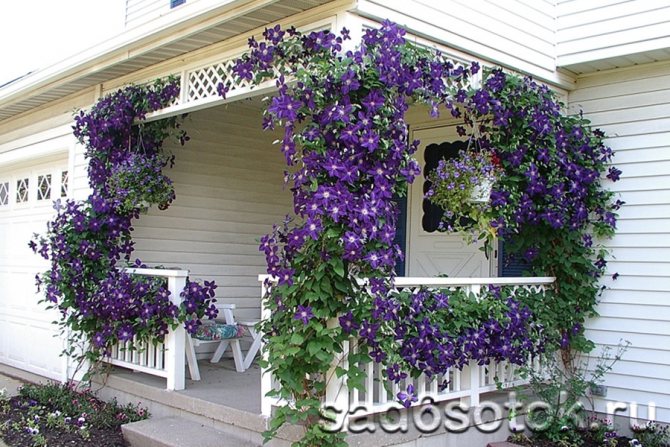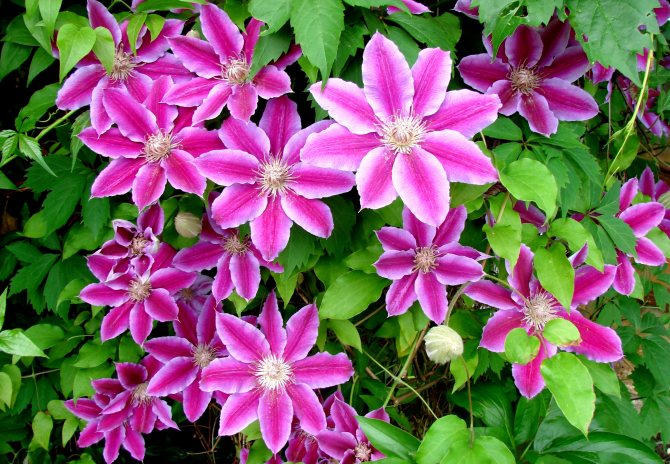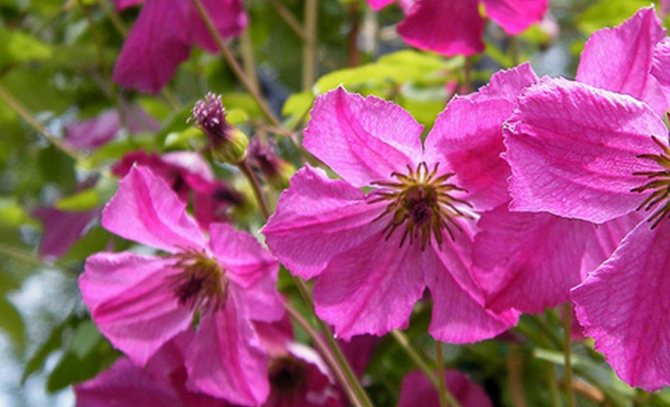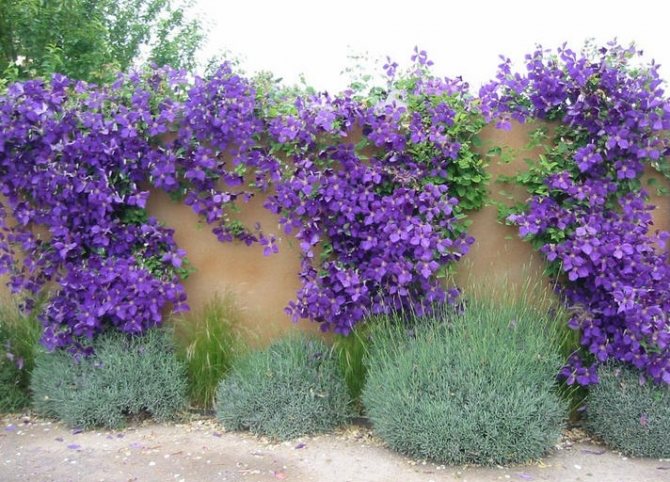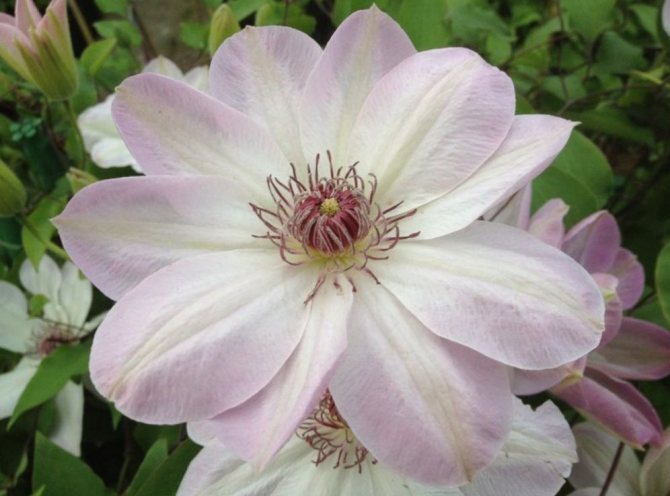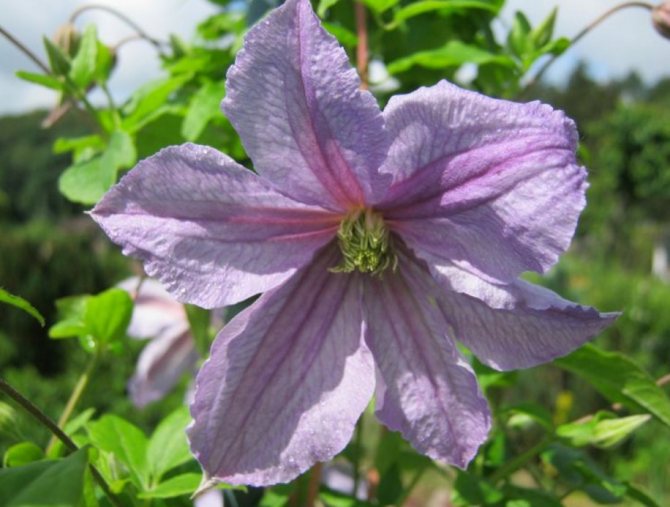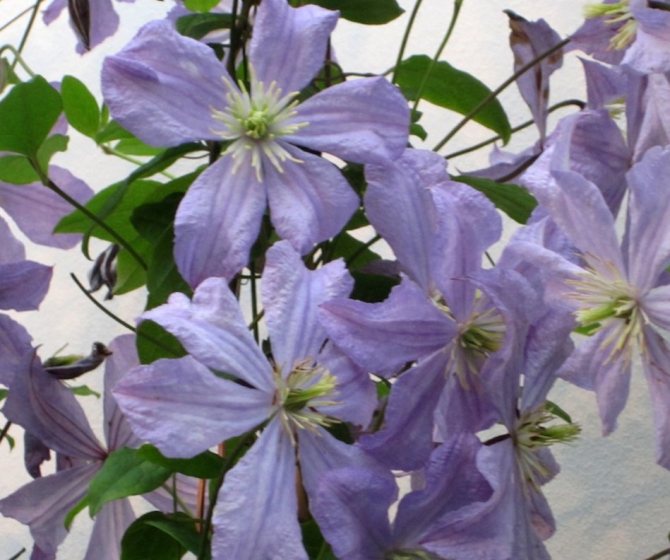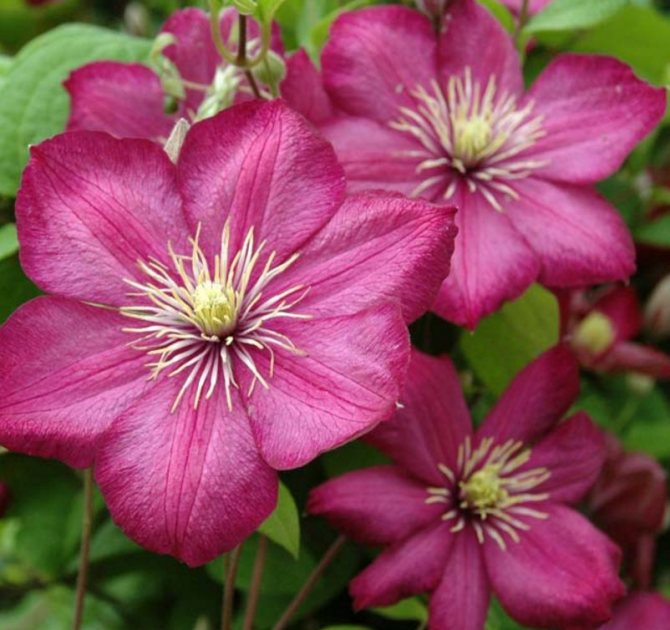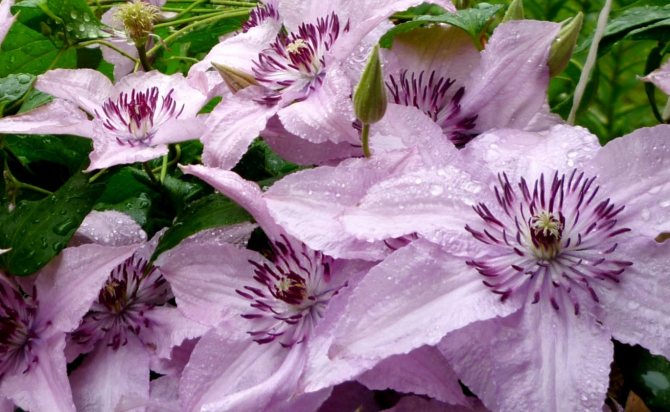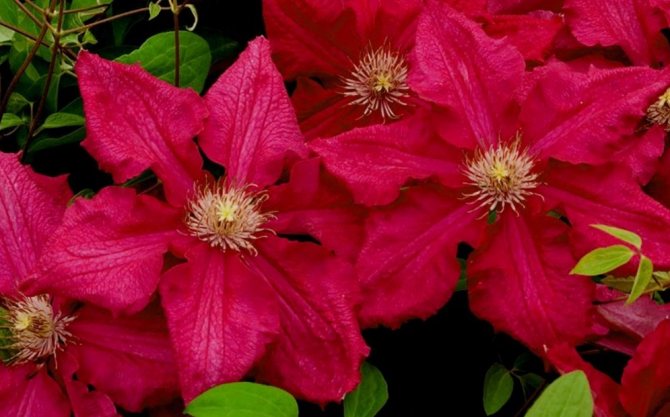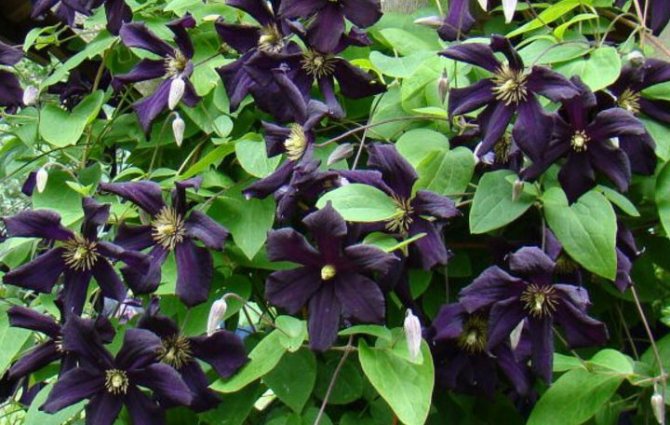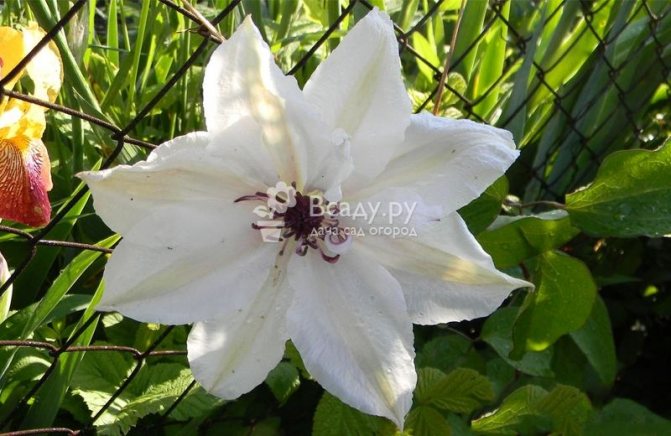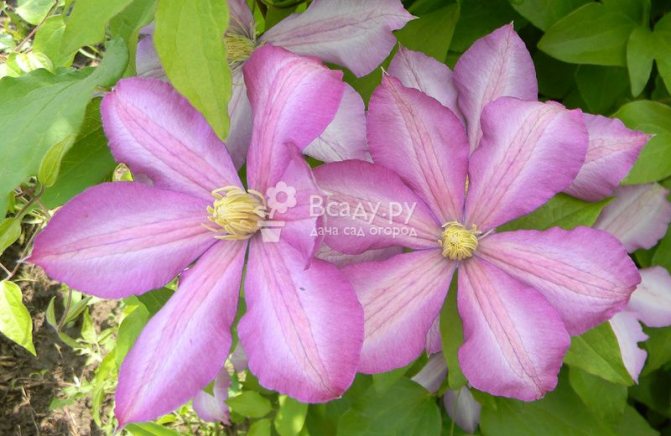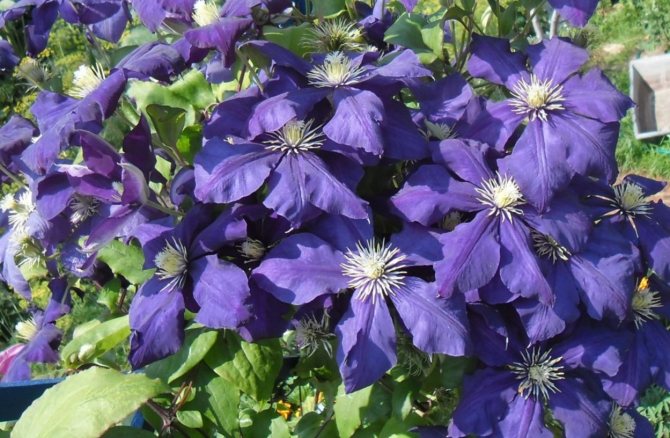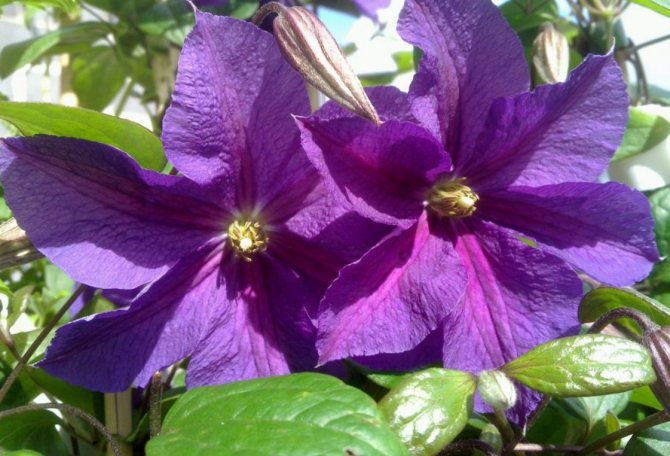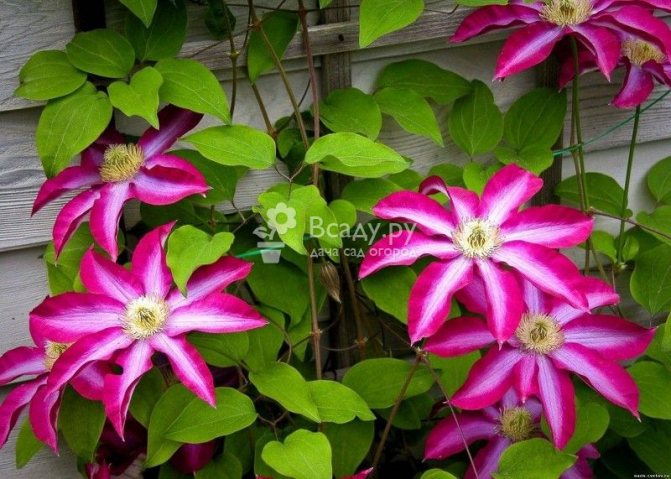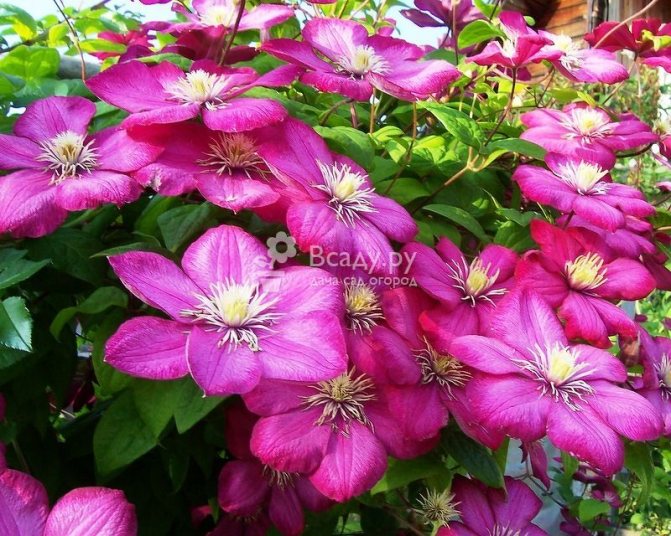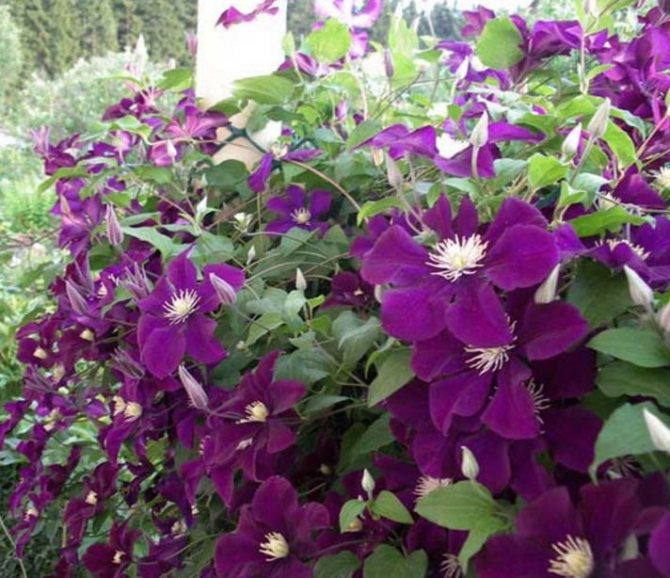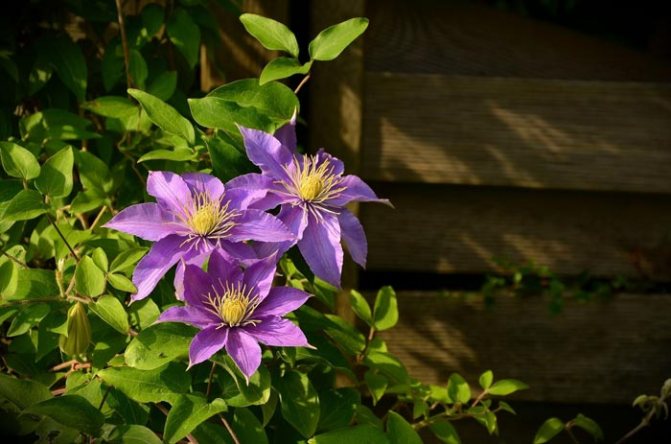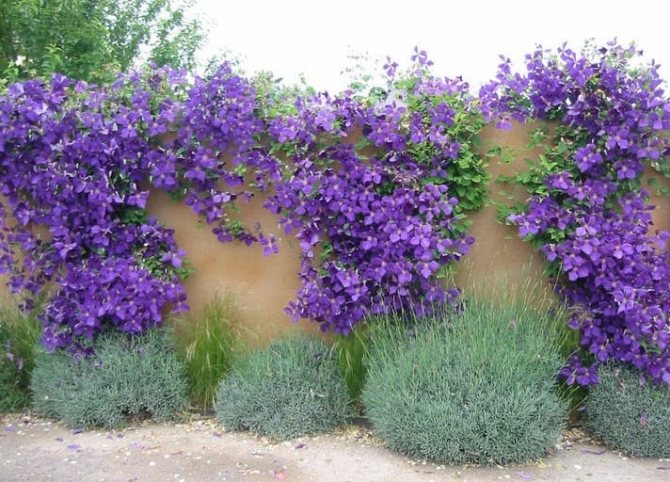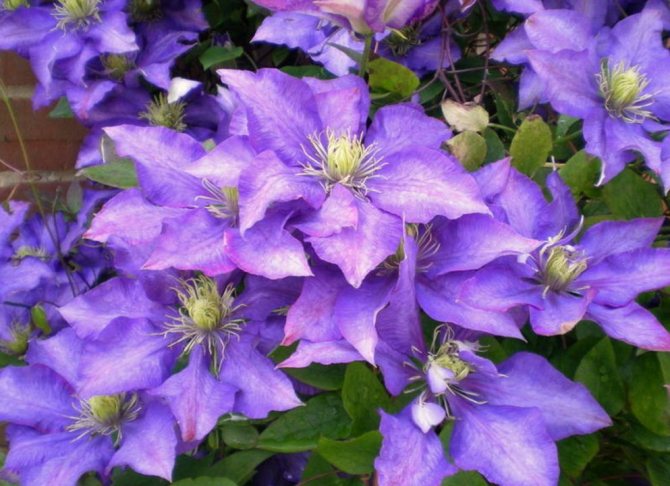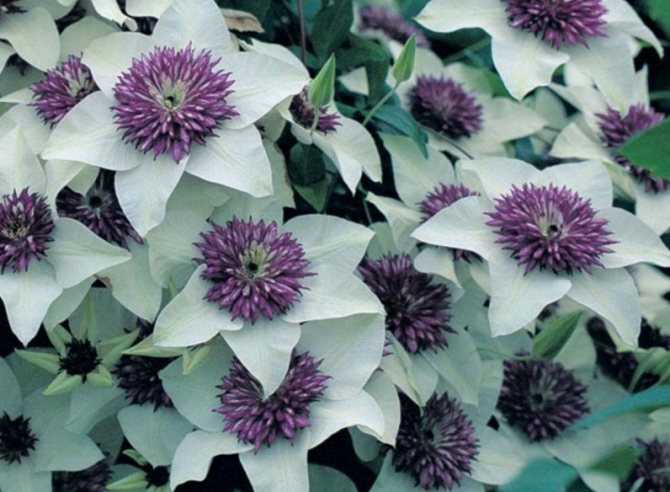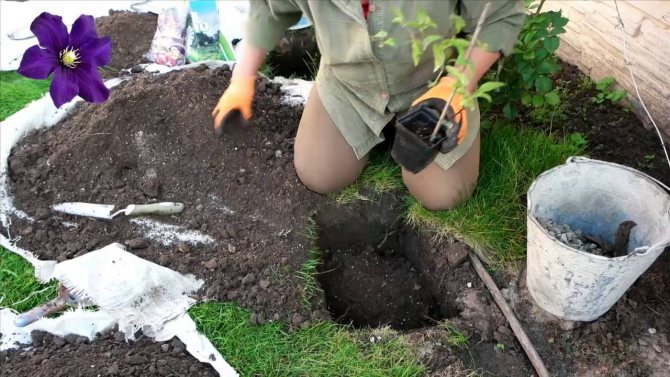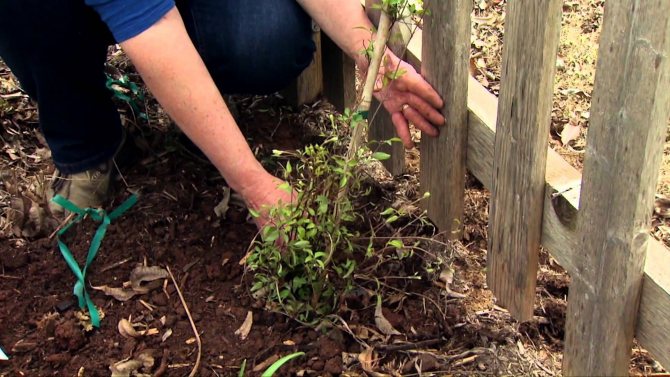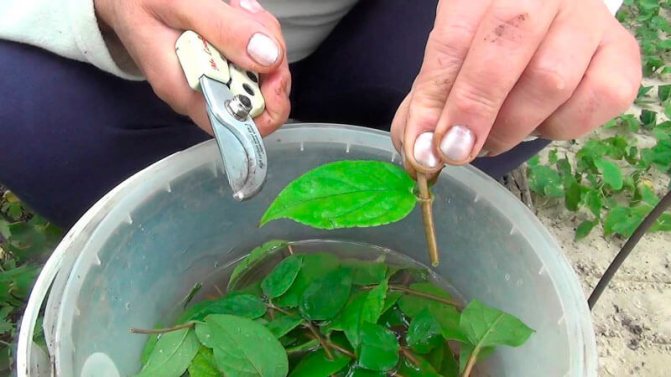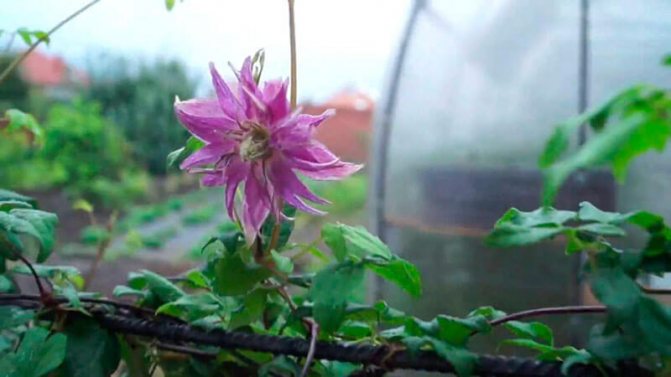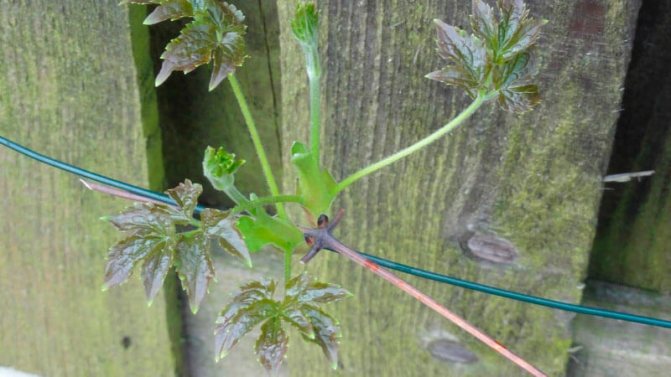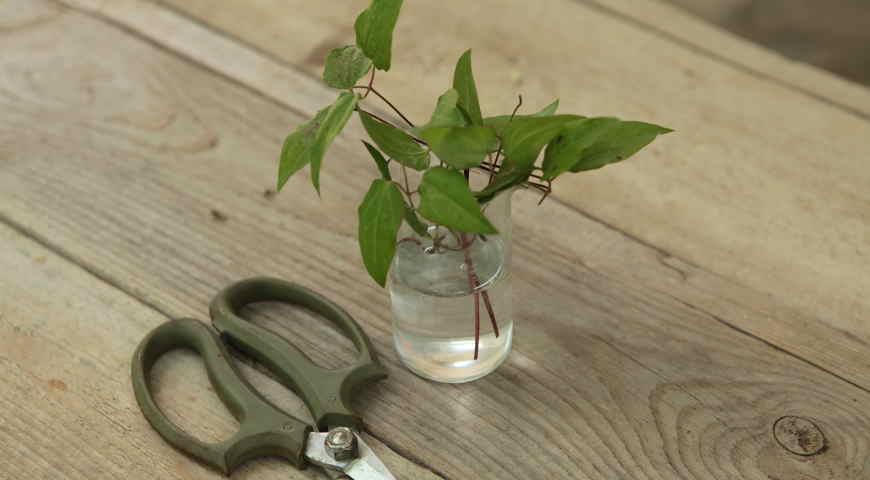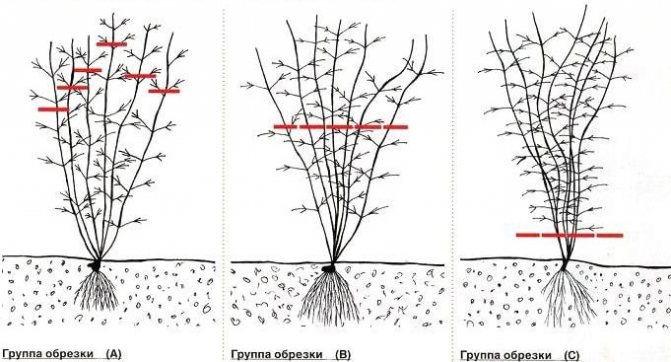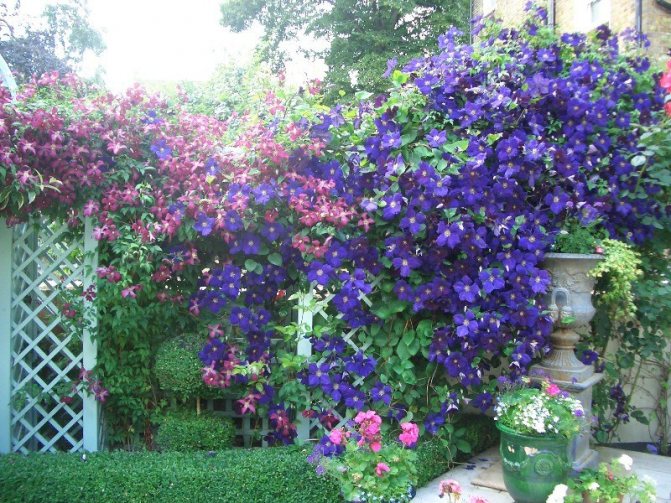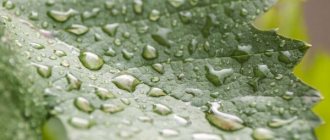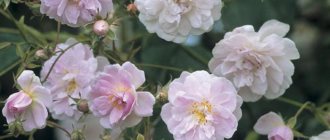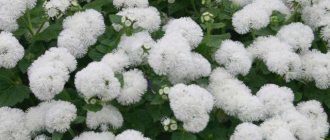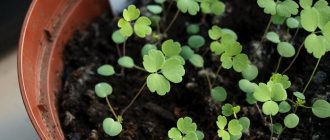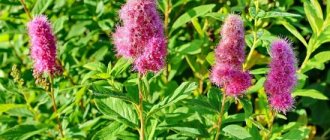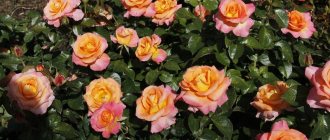Blooming clematis is a great picture. Star scattering framed by greenery will add a unique charm to the garden design.
Growing flowers is fun, but not easy. They are demanding on the soil, growing conditions, care.
In order for clematis to bloom magnificently and delight, it is important to properly care for them, to take a responsible approach to the choice of the variety, the place of planting.
Planting and soil requirements
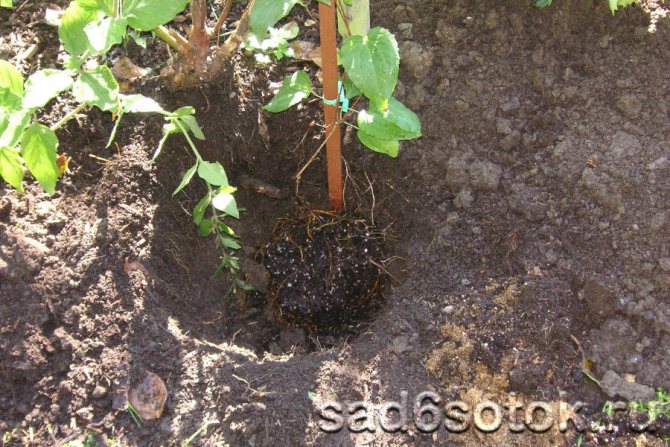
Planting clematis
Cultivation of clematis is in many ways similar to the cultivation of other ornamental perennials, but this culture has its own characteristics. When choosing a site for planting, pay attention to the following points:
- Clematis need protection from the northern and northeastern winds, since a strong gusty wind will break and confuse delicate shoots, pluck petals.
- Sunlight for at least 6 hours a day is a prerequisite for lush flowering. In the southern regions, it is preferable to plant the bushes in partial shade, otherwise they will suffer from the heat and may die.
- When clematis is planted along buildings, they retreat from the wall at least 40-50 cm so that the rainwater flowing from the roof does not erode the roots.
- When choosing a variety, it is worth finding out exactly how the flowers are formed - along the entire length of the vines or only at the ends of the shoots, depending on this, they plan to place the plant on a support (in the form of a continuous carpet or a falling cascade).
For the formation of strong shoots and long flowering, clematis need a fertile, light, weed-free soil of neutral acidity.
When landing take into account the following requirements:
- Clematis do not tolerate the close occurrence of groundwater (above 1 m), therefore, if necessary, the soil is drained by digging a drainage ditch.
- The planting hole is dug 0.8 m deep and 0.6 m wide, and a 15-centimeter layer of drainage from pebbles or rubble is laid on the bottom.
- To fill the pit, mix the extracted earth with a bucket of humus, adding ¼ cup of superphosphate, ½ cup of nitrophoska, 2 cups of wood ash.
- For good growth of clematis, neutral or slightly acidic soil (pH 5.6 - 6.5) is optimal. Acidic soils must be limed by adding 50-100 g of slaked lime to the soil mixture.
- A few days before planting, 2 buckets of water are poured into the pit, they try to plant the plants in cloudy weather.
- The seedling is placed by placing the roots on a mound of loose earth and burying the root collar 9–10 cm below the soil level, protecting the buds from freezing.
- After planting, the plant is watered and mulched with a thick layer of compost or humus.
You can find popular clematis varieties and their main characteristics in the article "Clematis varieties".
Frost-resistant varieties of clematis
Lemon Dream
This is a completely unpretentious plant to care for, and it also feels great in partial shade. It blooms with large beautiful flowers, up to 12 cm in diameter. Its flowers are light cream in color, with a lemon tint and a very pleasant grapefruit scent. It begins to bloom in May.
This variety will be the perfect decor for garden pavilions and fences.
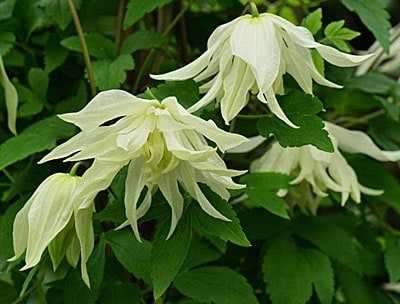

Markhams Pink
This variety is also quite unpretentious in cultivation. Feels quite well both in the sun and in partial shade. It begins to bloom from the beginning of May. He has very delicate, pink flowers with a violet hue. The lush bloom of these clematis attracts with beauty.It looks very impressive when used in decorating tree trunks, arbors, or as a ground cover plant.
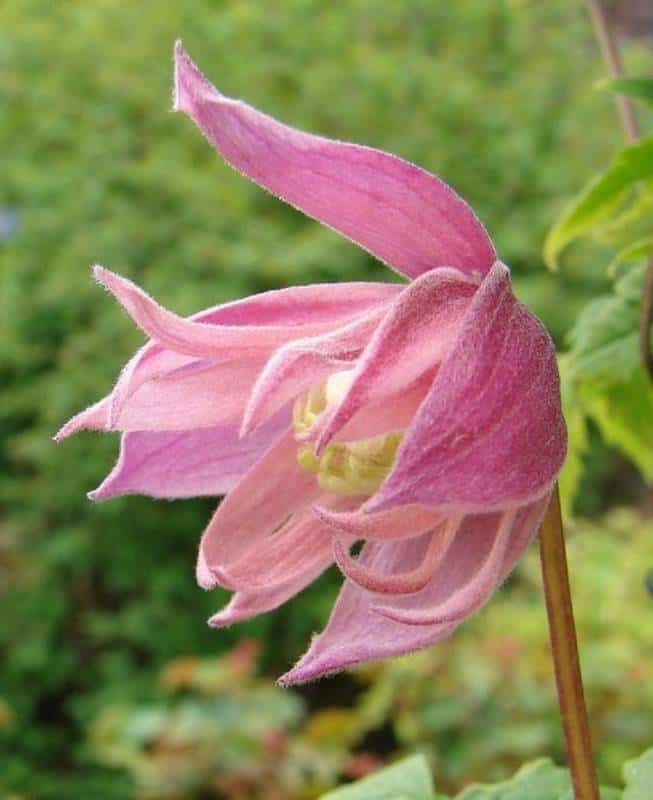

Maidwell Hall.
This frost-resistant clematis variety is quite tall and beautifully blooming. He has large flowers of blue, with a milky tint, color. When they are fully opened, they reach 9 centimeters in diameter. This vine begins to bloom in April, blooms for about a month. When clematis fades, fluffy panicles form in place of the flowers, beautifully decorating the plant until autumn.
This vine is rather unpretentious in cultivation and care, but does not like too dry and acidic soils.
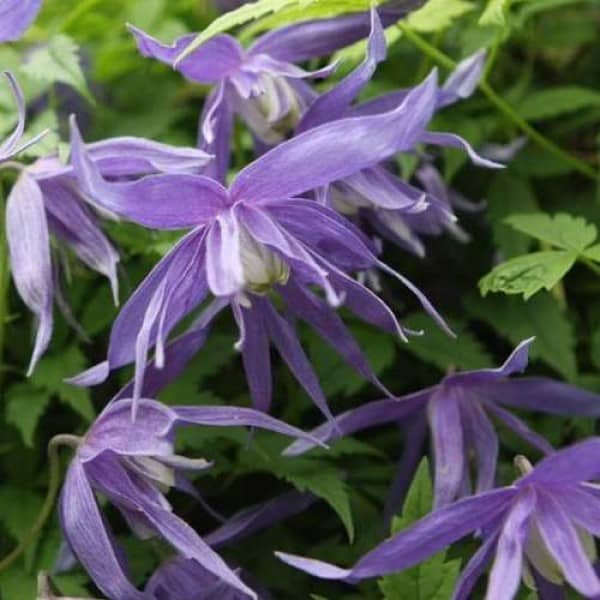

Purple Dream
This variety of clematis loves the sun, this is perhaps the only condition for breeding it. Purple Dream is a completely unpretentious clematis and tolerates temperature extremes in winter.
This vine has large, very beautiful flowers, a delicate mauve shade, reaching 12 centimeters in diameter. When in bloom, it fills the garden with the scent of grapefruit.
This clematis is very good for decorating various fences and arches. Also, the plant can be successfully used as a ground cover.


Stolwick Gold
Stolvik Gold - amazingly beautiful clematis, with yellow leaves, looks very impressive. Against a yellow background, its purple flowers are eye-catching. Its flowers are in the form of bent bells up to 6 centimeters in diameter.
This type of clematis begins to bloom in April and ends only at the beginning of summer. This is a plant of the first pruning group.
The plant is great for decorating fences and gazebos in the garden, various stones and supports, as well as a ground cover.
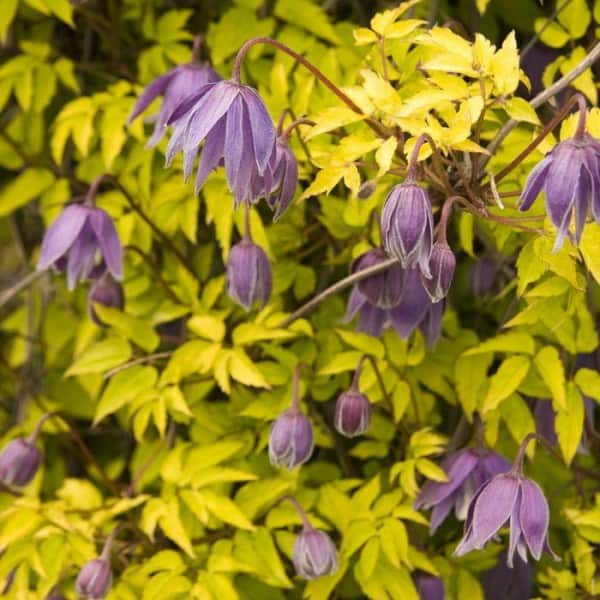

White Swan
This clematis belongs to the early flowering varieties. White Swan is a tall vine reaching three meters in height with very beautiful snow-white flowers that grow up to 6 centimeters in diameter when opened. This variety of clematis blooms closer to summer. The fluffy fruits that form after flowering persist until autumn.
White Swan perfectly tolerates winter drops in temperatures and is extremely resistant to disease. Clematis of this variety does not require pruning and is mainly used as a decor for tree trunks, various posts, and looks good as a ground cover plant.
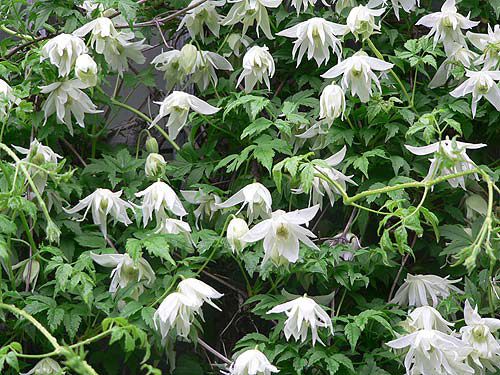

Care
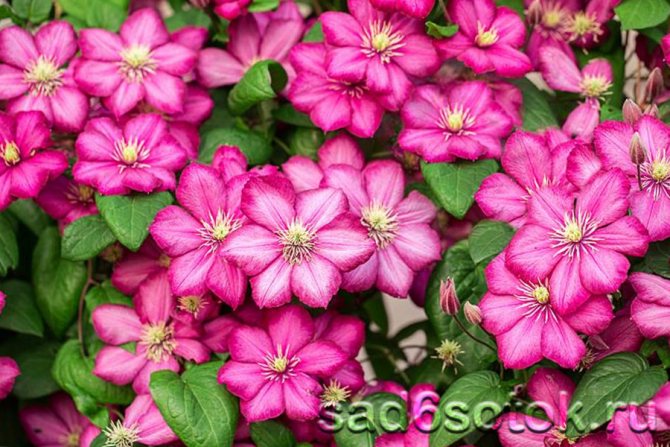

Clematis care
The main elements of care are regular watering, feeding during the growing season, pruning and tying the vines to the supports. Let's consider all the stages of work in order.
Watering
Regular watering is carried out every 7-10 days, soaking the ground to a depth of 40-50 cm - for planted seedlings and young bushes. For adult plants, the watering depth increases to 70–90 cm.
A few days after watering, as soon as the soil dries up, it is loosened, providing oxygen to the roots. If watering is not possible, frequent loosening of the soil will help clematis survive drought more easily.
In hot weather, watering is increased up to 2-3 times a week, which will allow the plant to remain blooming and not lose its decorative properties. Watering an adult clematis bush requires 3-5 buckets of water.
Top dressing
If the planting holes are properly filled, the plants are not fed for the first 2-3 years. In the future, fertilizers are applied every two weeks, while in the spring, at the beginning of intensive growth, fertilizing with nitrogen fertilizers is carried out; from the moment of bud formation and further - phosphorus and potassium.
They use both organic fertilizers - urea (1 tablespoon per 10 liters of water), chicken manure (1:20), and mineral fertilizers - Kristalon of different brands, according to the growing season.
At the end of summer, it is useful to add 2 cups of wood ash under the clematis bushes, the effect of which is universal - to lower the acidity of the soil, fight fungal infections and as a top dressing.
Garter
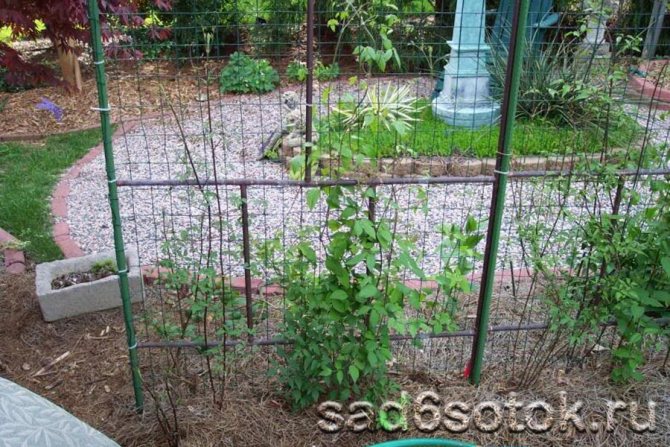

Clematis. Garter to support
Shoots are evenly distributed several times during the season and tied to a support. If you do not carry out the garter, the liana will lose its decorative effect, in places exposing the support, and in places forming dense thickets, which will create favorable conditions for the development of fungal diseases.
If the variety forms flowers at the tops of the shoots, the main shoots are tied up horizontally, and the lateral flowering vines are distributed vertically, creating a spectacular screen.
Pruning
Pruning is the most important technique that will allow you to form a bush on a support and get abundant flowering throughout the season. When pruning, you should take into account the variety of species, each of which has its own biological characteristics.
Large-flowered forms of clematis of the Viticella and Zhakman groups bloom on annual shoots, so in early spring they are cut off strongly, to the soil level, or 1-2 pairs of buds are left at the base of the shoots. Such bushes will quickly grow back and will begin to bloom by June. It is permissible to leave a few strong shoots not cut off, then flowering will begin earlier, it will not be so plentiful, and annual shoots will bloom only at the end of summer.
Large-flowered clematis of the Patens and Florida groups bloom on last year's shoots, therefore, in the fall, developed vines are only slightly shortened and covered, removing weak shoots in the spring.
Small-flowered herbaceous clematis with the ground part dying off in winter are completely cut off before sheltering for the winter or spring, as soon as the snow melts.
Species description of clematis
Clematis grow on almost all continents in completely different conditions: in a deep forest and among the steppes, on rocky gorges and fertile river banks. Wild clematis - climbing or bush - has small flowers. Gardeners tend to cultivate hybrids with large flowers. The color of the petals can be blue, deep blue, purple, red, pink, etc. Climbing plants are especially popular. Other characteristics of clematis:
- flowers are single or collected in inflorescences;
- the shape of the flowers is a half-umbrella, shield or panicle;
- foliage - complex (3.5 or 7 leaves), paired or simple;
- root - pivotal or fibrous.
Attention! Clematis with a rod system negatively tolerate transplanting and require a permanent place on the site.
It should be understood that the first variety that comes across in the climate of the Moscow region will not grow normally. Clematis just don't like the local cool climate with short-term winter frosts. Gardeners are advised to choose plants that bloom early. Those that can form inflorescences on branches that have grown in spring.
Attention! Terry varieties of clematis with flowering on overwintered shoots will produce flowers without a fluffy coating.
How to propagate clematis?
This decorative vine is successfully propagated by vegetative methods - dividing the bush, cuttings and layering... Seed propagation is laborious, and is used for breeding new varieties or for obtaining seedlings of species clematis.
Dividing the bush
This method does not give a lot of planting material, but amateur flower growers often use it as a reliable and least laborious one. The division of adult bushes is carried out at the age of 5-6 years, in spring or autumn, as follows:
- All shoots are cut, leaving 1–3 knots above the soil level.
- The bush is carefully dug, shaken off the soil and divided into parts with a sharp pruner, so that each seedling has a root system and several shoots with buds. Depending on the size of the mother plant, you can get from 2 to 8 seedlings.
- Places of cuts are burned with a strong solution of potassium permanganate or sprinkled with charcoal.
- Broken or weak roots are removed and the plants are planted in the prepared pits in the usual way.
The breeding method is close to the division of the bush. layering... To do this, in the spring, near the mother plant, they dig a groove 8–10 cm deep, which is covered with a mixture of fertile soil and sand.A shoot with vegetative buds is placed in the groove, bringing the top to the surface, and covered with soil.
The mother plant is regularly watered abundantly, and after a year the seedlings obtained along the entire length of the shoot are separated.
Cuttings
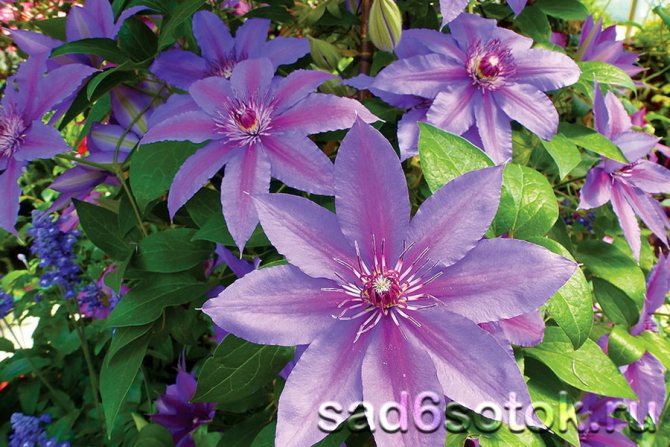

Reproduction of clematis
Reproduction by green cuttings is a great way to get a lot of high-quality clematis planting material, for which they perform the following actions:
- Two-layer soil is placed in the boxes:
- Before flowering, the entire shoot is cut off, its middle part is divided into cuttings with 2-3 pairs of buds. The lower sections are treated with a root formation stimulant (Kornevin, heteroauxin);
- When pruning uterine bushes, shoots with vegetative buds are left, from which higher-quality cuttings will be obtained than from shoots with generative buds that give color.
- a nutrient layer (15 cm) is laid on the bottom from a mixture of humus, sand and garden soil in equal proportions;
- the top mulch layer (3 cm) consists of sand or Zeolite.
- The substrate is well moistened and cuttings are placed every 5 cm in a row, leaving 10-15 cm between rows, after which the plantings are watered and covered with polyethylene or placed in greenhouses.
- In autumn, rooted cuttings are planted in separate pots or cups and placed in a room with a temperature of 18–20 ° C with weekly watering. In the southern regions, clematis cuttings with well-developed roots are planted in the ground in a permanent place and well covered for the winter.
When clematis is planted
In regions with a warm climate, flowers are planted in open ground in autumn: from late September to early November. In areas with long and cold winters, spring planting is preferable: April, May.
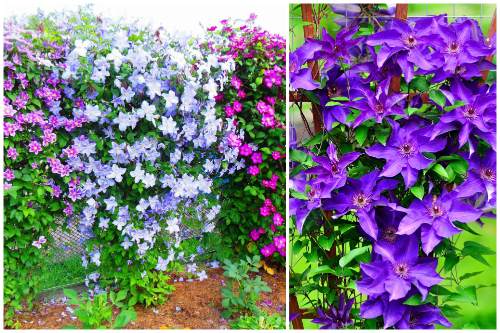

It is advisable to plant an adult plant purchased in a large container (container). It is easier for an adult clematis with a developed root system to adapt to a new place.
It is necessary to carefully examine the roots when buying so that they are firm, elastic, smooth. Blisters and growths on the roots indicate a plant disease (nematode). How clematis is planted: procedure.
- Pre-dig a pit 50x50 with a depth of at least 80 cm. The bottom of the pit is covered with drainage: gravel, chipped brick. Sprinkle on top with a nutrient layer: peat, manure or humus. 500 g of wood ash is also introduced there.
- For the convenience of transplanting from the container, it is first immersed in water. Then, carefully, without damaging the roots, they take out the plant along with a lump of earth, lower it into the prepared hole, straighten the roots and sprinkle it with earth.
- They do not fill up the hole to the top. A year later, when the shoots begin to grow stiff, the earth is added. It is necessary to leave an interval between the planting holes of at least one meter.
- Pruning shoots after planting is a must. Several buds are left (2-4). After a short pruning for 2 years, the root system develops and strengthens.
- The seedlings are watered with water, after which the mulch is laid out. It retains moisture and inhibits the growth of weeds.
- Over time, it is necessary to tie new shoots to the support so that they do not break from the wind.
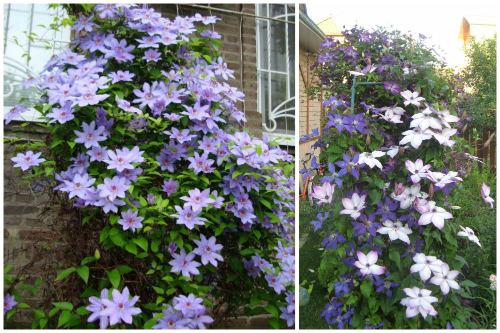

Diseases
Clematis are affected by fungal infections, the signs of the most harmful diseases and preventive measures are described below.
- Septoria characterized by the appearance on the leaves of brown or light brown spots with a lilac border. Affected tissues dry out and fall out.
- Disease fusarium annual cuttings and bases of young shoots are exposed. The lesion occurs in the form of a pale pink plaque, impairs vascular conductivity and leads to rapid wilting and death of plants.
- Gray rot manifests itself as an off-white fluffy bloom on green parts of plants, as well as on cuttings during storage. It develops more often in cold, damp weather.
- Brown-red, convex spots sometimes appear on leaves, shoots, flowers rustcovered with a powdery substance consisting of fungal spores.
- The main feature alternaria - the appearance on the leaves of oblong spots with a dark bloom, on the shoots the lesion is expressed by dark depressed ulcers.
- All parts of the plant when infected powdery mildew are covered with a white thin bloom, then the leaves and young shoots dry out. Outbreaks of this disease can be observed in dry hot weather, the lesion is more common in the southern regions.
Prevention of fungal diseases
- Before planting, the seedlings are immersed for 1.5 - 2 hours in a solution of copper sulfate at the rate of 5 g per 10 liters.
- After planting, dust the ground and shoots with foundationol powder.
- Before sheltering for the winter, the bushes and the ground under them are treated with one of the fungicides (copper sulfate 2%, Kuproksat, Blue Bordeaux).
- In the spring, as soon as the weather permits, remove all the leaves, remove weak and affected shoots and spray with 1% iron sulfate.
- During the season, with an outbreak of fungal infection, plants are treated with one of the garden fungicides (Strobi, Topaz, Split).
Diseases of clematis and their treatment
There are several different diseases that can affect the plant in question:
- rust;
- gray rot;
- powdery mildew;
- wilt, or wilting;
For every ailment, there is a required medicine on sale. In this case, treatment often involves the removal of damaged elements.
Clematis may not bloom due to pests or insufficient moisture. If flowers do not appear with the onset of the deadline, then you need to pay attention to the condition of the plant.
Pest control
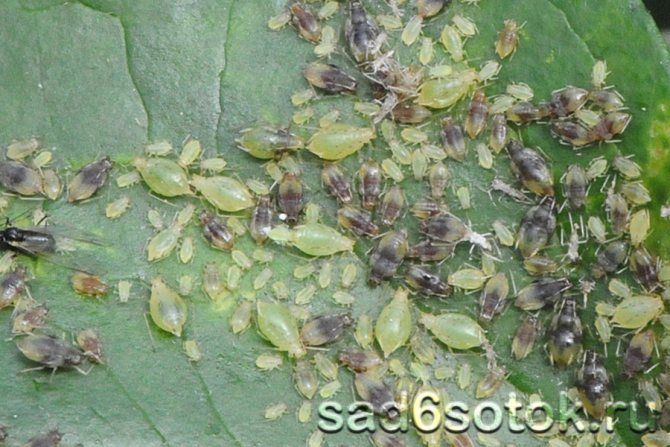

Clematis is threatened by aphid colonies
The greatest harm is caused by infection of the soil with a nematode, damage to plants by spider mites, mealybugs, and aphids.
To prevent infection nematode and scaleBefore planting, the roots of the purchased seedling are immersed in hot water (50 ° C) for half an hour. The development of the nematode is inhibited by mulching the soil with wormwood leaves, planting marigolds or calendula nearby.
In hot weather, young shoots attack aphid colonies, to combat this pest, plants are treated with a soap emulsion or pesticides (Bi-58, Decis).
Vs spider mite use acaricidal preparations - spraying with Arcerid, infusion of garlic or dusting with colloidal sulfur.
Growing from seeds and further care
If you decide to grow clematis from seeds at home, then first you should take care of the correct collection.
About working with seeds
The seeds ripen in summer or autumn, depending on the type of bush. They need to be collected and prepared for sowing. Clematis seeds have different shapes and sizes, but again this depends on the type of flower. Even on the same type of bush, seeds of different sizes ripen.
Usually a distinction is made between large, medium and small seeds. For planting, large and medium seeds are taken, and the little things just need to be thrown away. But the grains taken must also be sorted by size and planted in separate containers. You can purchase seeds from a specialty store.
The seeds of the plant are sown in the spring, right in the garden, or in the fall in the greenhouse.
In order for the germination rate to be high, and the seedlings to be strong and resistant to pests, the seeds must be hardened (stratified).
If sowing is planned in spring, then the seeds should simply be stored correctly - in a cool and dark place (temperature not higher than + 5 ° C). When sowing in autumn, the seeds should be placed in the refrigerator for 2-3 weeks.
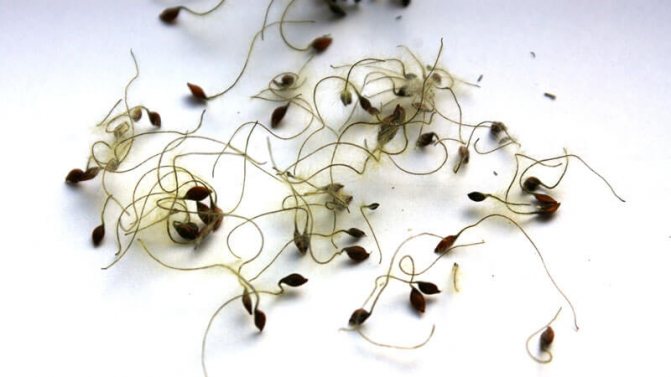

About the correct landing
Cultivation of clematis for seedlings must be carried out in boxes that can be kept outdoors in spring and on a windowsill in winter. The soil for this should be taken as nutritious; the best soil will be a mixture of humus, sand, ash and earth.
The sprouts begin to hatch after a long time - it can be 3 weeks or 3 months - this is influenced by the plant variety and germination conditions.
Until the first shoots appear, the soil should be moistened, try not to overflow. Seeds should be sown in grooves to a depth of 2-3 times the size of the seed itself. From above, the soil is covered with river sand and compacted a little. The sprout will better break out through the sand.
When sowing seeds in autumn in boxes by spring, they are ready for transplanting seedlings into open ground. Planting clematis in spring is done after the threat of getting under night frosts disappears, because clematis is a delicate plant and is afraid of cold weather, regardless of the variety.
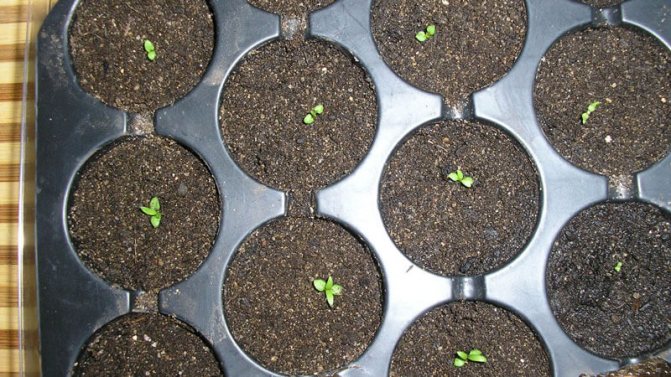

The place for planting clematis seedlings should be sunny, but the root system should be in a shaded place. It is recommended to choose the site protected from the wind, because clematis do not tolerate drafts.
You should also think about the fact that this is a vine and it will need a support for which curly shoots can catch on. If the seeds were sown in spring, then by autumn the seedlings will be ready. Her further fate has two options:
- plant seedlings in open ground, followed by covering the bushes from winter frosts with straw, fallen leaves, or cover with foil;
- the second way is to leave the seedlings in boxes, placing them on the windowsill until spring.
How to keep clematis before planting? Video:
How to cover clematis for the winter?
Clematis are resistant plants and tolerate severe frosts down to -35 ° C, therefore they are sheltered only in the northern regions, and in the southern regions it is enough to sprinkle the base of the bush with a mound of earth.
In the fall, on those varieties for which this is provided by agricultural technology, a short pruning is performed, and then they dig deep into the soil - such a measure will prevent cracking of the earth and delay the snow.
They begin to shelter in dry weather when the onset of persistent frost... The bush is covered with a box or a wire frame is installed. The structure is covered with roofing material, other dense material and covered with 1-2 buckets of earth, peat or humus, after which snow is shoveled from above.
In varieties with long pruning, the shoots are removed from the support, if necessary, shortened a little, twisted, laid on a layer of branches or spruce branches, and then covered, as described above.
Features of planting clematis in the climate of the Moscow region
In the climate of the Moscow region, clematis are usually planted in early autumn or spring, after the last night frosts. A place on the site for a shrub should be selected well-lit, without drafts. True, it is better not to plant clematis in the sun, they also do not tolerate the heat very well. Also, do not plant the plant close to a wall or fence.
The landing site should be deeply dug and loose, with good drainage. Acidity - neutral or close to that. During the growing season, starting from planting, the plant needs regular feeding. However, you should not add fresh organic matter or peat: you will only make it worse.
Advice. Damp, heavy, too saline or acidic soil is unacceptable for the culture. Clematis are planted so that in the next season they can be deepened even more by adding a little earth.
Soak the roots in water a couple of hours before starting the process. Put a small hill in the seedling hole and distribute the roots evenly over it. After planting the plant, it must be cut off. A little later, the procedure should be repeated. Also, a young plant needs a grid or lattice as a support - it will cling to it with leaf stalks and will soon decorate the site with a kind of green rug. The height of the support is about 2 m.
WHEN GROWING KLEMATIS, THE MAIN THING IS CUTTING
The correct formation of clematis determines their health, longevity, appearance and flowering intensity. By the method of flowering, clematis are divided into 3 groups. Each has its own pruning.
First group.
In the varieties of this group, most flowers are formed on the shoots of the current year.Their flowering begins in late June - early July and lasts until the end of September. In these clematis, annual shoots die off by the end of October, and grow back the next year.
But if 2 - 3 nodes are left on old shoots, then next year they will bloom in June - before the bulk of flowers bloom on young shoots. Therefore, the old shoots are not completely cut out (leave 20 - 25 cm).
The varieties of the first group are the most frost-resistant.
Second group.
The varieties of the second group bloom twice a summer.
The bulk of flowers are formed on last year's shoots in June and continues until the end of July.
At the end of July, flowers bloom on one-year-old shoots.
On them - the flowering is weak, so these vines are not cut off at all.
In the fall, only the faded part is cut off.
If the bush is thickened, it is thinned out.
Third group.
These are varieties in which flowering occurs on all shoots (current and last year).
On last year's - early flowering (May - June), on current ones it begins in July and ends in October.
In these varieties, last year's shoots are greatly shortened (they leave 30 - 40 cm), and annual ones - by 1/3 of their length.




